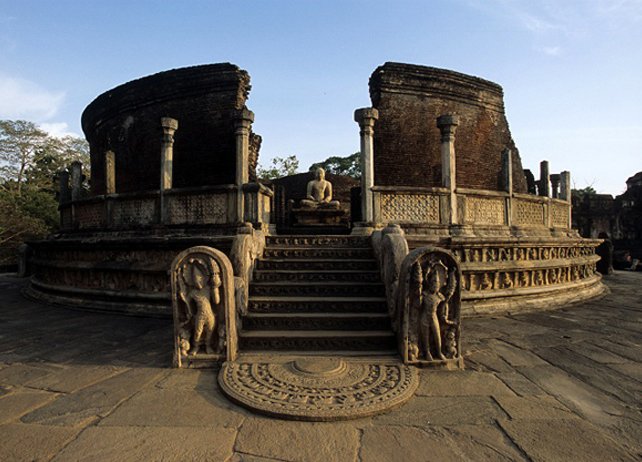Where am I : India Tour Packages » Most Popular Packages » Pottuvil Tour Packages
View Details

Destinations Covered : Colombo » Pottuvil » Kudumbigala » Okanda » Kumana » Yala » Kataragama » Galle
Tourism of Pottuvil
Thinking of traveling to the east coast of Sri Lanka and wondering what to see and do in Pottuvil? It is undoubtedly the Surfer's Paradise of Sri Lanka, and apart from surfing at some of the best spots on the island, the Tourism of Pottuvil offers you many other attractions. Pottuvil is generally full of birds, wildlife, jungle areas, wetlands, and large lagoons. The destination offers you a wide range of activities, be it relaxing on one of its numerous beaches, parties, visiting interesting temples, doing off-road motorcycle routes, or visiting one of its National Parks. You are unlucky if you don't see an elephant in this area. It is common to find elephants in their natural habitat just by leaving a couple of kilometers from Pottuvil. Therefore, it is recommended that you be careful if you are driving a tuk-tuk or a motorcycle. It is considered one of the best surf spots in this world. This region is surrounded by jungle, and a broad coastal strip stretches to the iconic Crocodile Rock, where surfers from all over the world gather and from which you can watch the movements of wild elephants. This article will discuss holidays in Pottuvil, attractions, entertainment, and beaches.
Just a little bit of Pottuvil
Pottuvil is a relaxed town with a small market area and several local restaurants, such as New Makkal. On the main road that offers excellent rice & curries for lunch. Pottuvil also has a grand mosque to visit, the Al Muneera Mosque, and a lovely beach with a surf spot, Pottuvil Point. . If you want to take a boat trip in its beautiful lagoon, go directly to the place and bargain with the anglers for the price, ideal for bird watching and to spot wild elephants and crocodiles. Previously, an ancient state was located on this territory. In addition to various buildings, an irrigation system functioned here. Thanks to the existence of a small reservoir, everything around flourished and prospered. The climatic conditions of subsequent years ruined everything. The reservoir dried up, people and animals died out, and the remains of the former state were buried underground. In the early 20th century, the British made this area a protected area.
What you need to know?
It is worth remembering that out of the 12,000 inhabitants of Pottuvil; approximately 80% are Muslims who live by their laws. Therefore, shops do not sell alcoholic beverages, and tourists should behave modestly and decently. You must wear closed clothes to get out into the city, especially for girls. Those wishing to rent a bike must make themselves a Sri Lankan driver's license. International ones do not work here. You can get them from the Department of Road Traffic. You can make temporary rights in offices that provide rental vehicles. Pottuvil generally is more suitable for sports and outdoor activities than a traditional resort pastime. There are no luxury hotels, expensive boutiques, or various restaurants, but there are big waves and unique nature.
Looking for nearby attractions of Pottuvil
People go to Pottuvil for surfing, diving, and fishing. However, lovers of a more relaxing holiday can find something to their liking. There are several historical, cultural, and natural attractions in the Pottuvil area, some of which we will present below. These will not be all the sights of Pottuvil, but the most famous ones.
Arugam Bay Beach
The local beach -Pottuvil Point - is a wide and long strip of pure white sand. The beach is perfect for surfing and a relaxing holiday on the coast. Whiskey Surf Point is a more comfortable beach with sunbeds, showers, a bar, and evening fun. You can get there by tuk-tuk. It is necessary to agree with the driver in advance on the time when you will be picked up back and, of course, on the price and do not give money in advance.
Crocodile rock
From a distance, the rock looks like a pair of crocodiles. The area boasts wildlife, with elephants roaming around and eagles flying overhead.
Surfer wave and calm lagoon
The locals will tell you that their beach is one of the top surf spots in the world. This is, of course, an exaggeration. Experts would place him in the top five. The wave here is from a meter to one and a half and long. It is ideal for an intermediate-level surfer. For swimming, a place where the waves are calmer is suitable - this is a slight bend in the lagoon. Adults and children can enjoy the sea and the sun with pleasure. The only caveat of the beach is that it is wild and not equipped. There are no usual sun loungers, umbrellas, and cafeterias. Therefore, before going to the beach, it is necessary to take with you, in addition to a towel and sunblock, fresh water, awnings or beach umbrellas, and a hat. You can swim all year round except during the winter months.
Elephants alive and in stone
Excursions are conducted through the jungle and the surroundings of the resort. Local guides suggest visiting the Pottuvil lagoon by canoe. Travelers will be able to see unique mangroves. You can travel deep into the jungle by motorcycle or jeep. There are two national parks near Pottuvil.
Lahugala
Lahugala - the park is famous for its massive population of elephants. This area and the remains of the temple located in it are attractive. Some buildings are well preserved. Just wandering among these "stones" is probably not interesting. Therefore, before visiting, it is recommended to familiarize you with various legends of the origin of the temple. A stupa, a monastery, and ponds on a vast territory. At the entrance to the temple lies a moonstone depicting elephants. According to one legend, every fourth elephant is depicted with a driver on its back, and according to another, they are just elephants. In general, there is some mystery in this. It is necessary to find out everything from the guide on the spot.
Muhudu Maha Viharaya
The Buddhist temple has some well-preserved stone statues in Pottuvil among the beach's dunes. It is believed that the temple was built where Princess Vihara Maha Devi landed.
Animals nearby!
Well, now - in the car and into the wild! People are in a "cage," and animals are free. Go! Firstly, around blinding eyes, greenery. Wild boars roam freely by small ponds. Handsome peacocks are everywhere. Local elephants are unpredictable, so it's better not to risk and not get close. Here you can enjoy the fantastic nature of Sri Lanka, admiring the flocks of birds of paradise and migratory birds. Sika deer, bears, buffaloes, leopards, mongooses, flying squirrels, and other animals live in the national park. And the rest you need to see in reality, everything around is "not ours," very unusual, sometimes scary and curious. And if you move further away from the animal cluster, you can see the sea fountain. The locals call it the Singing Hole. It is worth knowing that hiking in the jungle is prohibited. Of course, you can unofficially bypass the bans and go on a trip. Still, it would be best if you remembered that the jungle is quite dangerous with predatory animals and poisonous snakes.
Magul Maha Viharaya
This temple boasts the best-preserved moonstone in all of Asia. The Magul Maha Viharaya Temple, built during King Dahatuna, is also believed to be the site of the royal wedding of King Kavantissa and Princess Vihara Maha Devi. It is located eight kilometers west of Pottuvil along the main A4 road.
Yala National Park
It is the furthest and the second largest on the island. Made up of immense forests, grasslands, and lagoons that border the Indian Ocean, you can see elephants, crocodiles, leopards, and a wide variety of bird species.
Leopard walking on safari in Yala national park Sri Lanka
So if you want to complement your visit to this area, book your tour and go for it. However, remember that the primary access is from the southern coast of Sri Lanka for a safari in Yala National Park.
Whiskey point
Whiskey Point is a well-known vantage point of Pottuvil, known mainly as a surfer attraction and hosting weekly parties on Wednesdays and Fridays. The exact origin of the place's name is unknown. According to one version, it comes from the Tamil word "whiskey," which means "swirling." The name fits the description quite well, as the water in this region often feels rough, making it suitable for surfing.
At Whiskey Point, mainly foreign surfers of primary and intermediate levels of training gather, who are attracted by the presence of frequent strong waves 1-4m high and 300m long, a sandy bottom with no pitfalls, rips, and sea urchins. The waves break perpendicular to the shore without needing to swim far from the shore. The quality of the surf does not depend on the tide, but July, August, and September are considered the high season. To the north of Whiskey Point is the long, almost deserted sandy beach of Komari. You can find many small hotels, bars, and restaurants near Whiskey Point.
Zoo in reverse
If you are tired of being lazy on the seashore, it's time to cheer up. To do this, there is Yala Park, located about 25 km. It is divided into two parts. The eastern one is closed to the public - excavations are underway there. But the western one is just for the calm tourist.
Magul Maha Viharaya
This temple boasts the best-preserved moonstone in all of Asia. The Magul Maha Viharaya Temple, built during King Dahatuna, is also believed to be the site of the royal wedding of King Kavantissa and Princess Vihara Maha Devi. The ruins of an ancient complex located in the city of Lahugala, at the borders of the national park of the same name. The exact date of construction is unknown. According to the most popular version, the Magul Maha Viharaya temple complex was created in the 2nd century BC, when the territories in which it is located belonged to the Sinhalese kingdom of Ruhuna and was subsequently supported by the following kings. During the heyday of the complex, 12,000 monks lived in the temple. Until now, the house of the image of the Buddha and the Bo tree, the moonstone, the ruins of the palace, the main gate, and the remains of the walls surrounding the complex have been preserved. The remains of other buildings are hidden underground.
Pottuvil lagoon
The Pottuvil freshwater lagoon is located near the city of the same name and 4 km from Arugam Bay. The lagoon covers an area of ??about 80 hectares, framed around the perimeter by mangrove forests and lotus ponds. In the center of the lagoon is a tiny mangrove island. Despite the water's dark color, the reservoir's depth is minimal. Boat trips on rowing boats or rafts are held along the Pottuvil Lagoon. During a boat trip along the lagoon, you can see small shrimp farms set in running water, and many species of birds, including herons, kingfishers, eagles, pelicans, kingfishers, and giant monitor lizards, monkeys, buffaloes, live along the banks. Also, in the lagoon, you can often meet large crocodiles basking on stones and elephants, either one by one or in small herds to the reservoir's banks in search of food and swimming.
Kudumbigala Cave Monastery
Kudumbigala Monastery is located on the reserve's territory of the same name, not far from Okanda and the entrance to the Cumana National Park. The cave monastery was built in 246, during the reign of the Sinhalese king Devanampyatissa, and after some time, it was abandoned. It was only rediscovered in 1954. In total, archaeologists have discovered more than 200 caves on the territory of the Buddhist complex, the walls of which are covered with plaster and decorated with frescoes. The only cylindrical dagoba surviving in Sri Lanka today is located in this monastery.
Kumana national park
Kumana National Park's territory is a wetland surrounded by a dry tropical forest zone. The national park includes a bird sanctuary of the same name. Every year from April-July, tens of thousands of birds in the world arrive in Kumana. More than 430 species of birds live in the park permanently. In addition to an abundance of birds, Cumana is home to 30-40 elephants, leopards, jackals, wild boars, European otters, crocodiles, and several endangered species, including rare turtles. Kumana Park has 20 lagoons and many small natural pools with fresh water. The territory of Kumana Park has been inhabited by humans since the 3rd century BC, as evidenced by rock inscriptions found on its territory. The Pada Yatra pilgrimage route passes through the park, carried out by pilgrims traveling from Jaffna to Kataragama during the Kataragama Perahera festival.
Things to do in Pottuvil
- The Pottuvil area is suitable for active and passive tourists. You can enjoy a beach holiday on the bay, but if you want to be active, you will find a lot of entertainment here. Chief among these are surfing, diving, and bird and animal watching.
- Pottuvil is famous for its fantastic waves that attract surfers from all over the world. The main surf spots in the area are Pottuvil Point, Main Break, and Crocodile Rock.
- Nature lovers can see elephants strolling along the road in the Pottuvil area. In addition, you can go on a safari, during which you will have the opportunity to see wildlife such as giant elephants, wild boars, deer, and crocodiles.
- In addition, you can see flocks of birds that migrate to the Arugam Bay area in November and December.
How is the food industry?
All hotels, restaurants, cafes, and other tourist places are located along the beach's main street. In the evening, it is crowded here. A barbecue is set up near the cafe on the street. Seafood and fish will be cooked right before you and served with delicious potatoes and fresh salad. The portion is enormous, enough for two. Cafes for every taste can be found on the streets of Pottuvil. Local food is spicy for a European, so when trying something national, do not forget to order water. Good reviews can be found about the Flo restaurant! Restaurant. Here you can taste the local cuisine. Pizza is recommended to be tasted at Pizza Hub, where you can watch the virtuoso work of the chef.In Bambini's Cafe, you can have a great meal. Be sure to try the national rotti - pancakes with different fillings and kotti - these are already finely chopped pancakes mixed with vegetables, meat, etc.
Climate and best time to visit
Compared to the rest of the island, there is relatively little rainfall and many sunny days. However, the wind constantly blows from the sea, which refreshes and makes it possible to endure the unbearable heat. In September-October, it rains, and the wind direction changes to the north. The tourist season on Pottuvil is considered the period from April to September. Nevertheless, you can come to the resort at any time of the year, depending on the purpose of the trip. The period from January to March, when the weather is quite hot, and the wind blows from the northeast, is ideal for windsurfing, rafting, and fishing. The beginning of winter is well suited for a leisurely rest, watching flocks of migratory birds that flock here for the winter, and riding motorbikes and motorcycles. In April, the surfer season begins: the wind changes to the southeast, and the air and water warm up enough for swimming. Autumn is the time for photographers, as the soil, exhausted by the drought in the summer, finally receives the long-awaited moisture, and picturesque green landscapes bloom.
When you are satisfied with the excursion, instead of facing the bumpy return Tourism of Pottuvil, you can spend the night on the nearby coast, in an experience of absolute peace in the tents mounted on the beach, eating fish grilled on the fire. You will have nothing else to listen to the waves crashing on the water's edge and, as a dark-eyed surf instructor would say, "relax."
Speak to our Experts!
Instant Quote, Best Deals - 100% Customizable, Includes hotels + car + guides Cost depends on various factors like, number of people you are, travel dates, category of hotel and transportation etc.Drop your Inquiry to get the best deals as per your requirements. 100% Satisfaction Guaranteed. Rated 5* in TripAdvisor.Loading...




